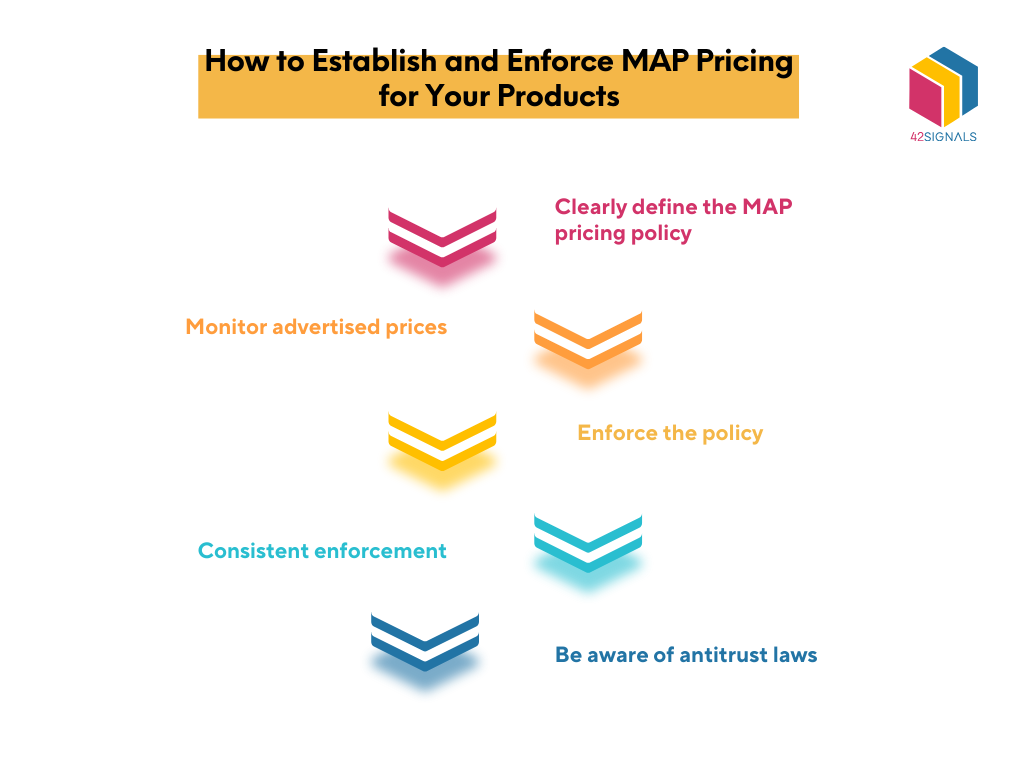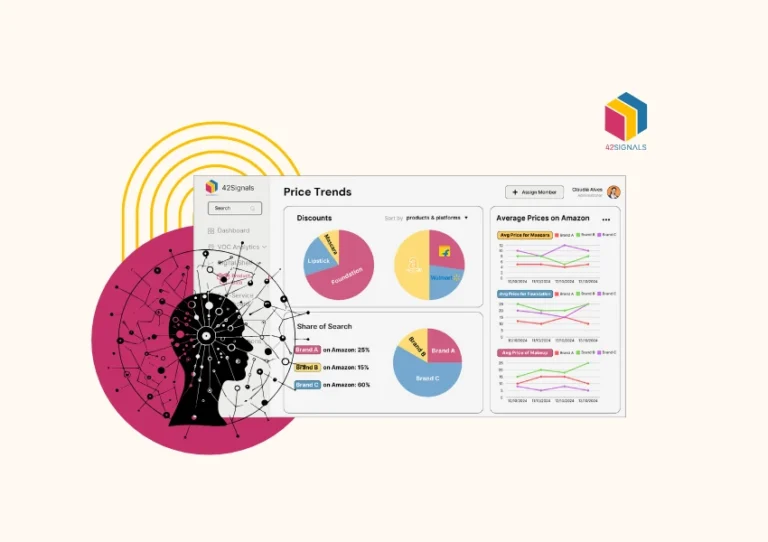What is Minimum Advertised Price Violations Policy?
Minimum Advertised Price Violations Policy (MAP violation) is a pricing policy that manufacturers or suppliers may enforce for their products, dictating the minimum price at which their resellers or retailers can advertise their products.

The purpose of a MAP policy is to ensure that all retailers advertise the product at a minimum price to maintain a certain level of brand image, and product value, and to prevent price wars between retailers. MAP enforcement in a nutshell pertains to making sure the MAP policy isn’t violated.
While MAP pricing does not prevent resellers from selling a product at a lower price, it does restrict them from advertising prices below the MAP.
In other words, MAP pricing sets a floor price for advertised prices, which helps prevent price erosion and maintain the perceived value of a product; minimum advertised price violations help detect such instances. Now let’s learn about MAP enforcement.
How to Establish Minimum Advertised Price Policy and MAP Enforcement
To establish and enforce MAP pricing for products, retailers should follow these general guidelines:

- Clearly define the MAP pricing policy: Retailers should clearly define their MAP policy and communicate it to their suppliers, resellers, and customers. The policy should outline the minimum advertised price for each product, the consequences of violating the policy, and how the policy will be enforced.
- Monitor advertised prices: Retailers should regularly monitor the advertised prices of their products by their resellers and online marketplaces. to ensure there are no MAP pricing violations. This can be done manually or through automated software that tracks advertised prices.
- Enforce the policy: When a retailer discovers that a reseller has advertised a product below the MAP i.e. when a MAP violation occurs, they should take corrective action to enforce the policy. The corrective action may include contacting the reseller to remind them of the policy or terminating the relationship with the reseller.
- Consistent MAP enforcement: Retailers should consistently enforce the MAP pricing policy to maintain its effectiveness. Inconsistent enforcement can lead to the perception that the policy is not serious and can encourage resellers to violate the policy.
- Be aware of antitrust laws: Retailers should be aware of antitrust laws that prohibit collusion among competitors to set prices. MAP pricing is legal as long as it is a unilateral decision by the manufacturer or supplier and not the result of collusion among competitors.
By following these guidelines, retailers can ensure that their products maintain a certain level of brand image and prevent price wars between retailers.
This ultimately benefits both the retailer and the manufacturer, ensuring that their products are perceived as high-quality and retaining their value in the market.
Benefits and Drawbacks of Implementing a Minimum Advertised Price Violations Policy
Implementing a MAP pricing policy can have both benefits and drawbacks.

Image Source: Priceva
Benefits:
- Brand image: MAP pricing helps maintain the brand image and perceived value of a product. A minimum price requirement prevents the product from being perceived as a low-value item, which can be harmful to the brand image.
- Control over pricing: MAP pricing gives manufacturers and suppliers control over the pricing of their products. This helps to prevent price wars among retailers, which can result in reduced profits for all parties.
- Identifying unauthorized sellers: Over 80% of resellers in the US are unauthorized sellers. MAP price monitoring can help businesses identify and remove these unauthorized sellers.
- Fair competition: MAP pricing ensures fair competition among resellers, preventing smaller retailers from being driven out of the market by larger retailers who can afford to sell products at a lower price.
- Improved profit margins: MAP pricing can help maintain a consistent profit margin for manufacturers, suppliers, and resellers, as it prevents retailers from undercutting each other on price.
- Better product quality: MAP pricing can lead to better product quality, as manufacturers can use the minimum price requirement to ensure that retailers do not undervalue their products, which can ultimately result in cutting corners or using lower-quality materials.
- Enhanced customer perception: MAP pricing can improve customer perception of a brand or product by establishing it as a premium or high-quality product, leading to increased brand loyalty and customer satisfaction.

Image Source: Track Street
Drawbacks:
- Reseller resentment: Resellers who are forced to adhere to a MAP pricing policy may resent the manufacturer or supplier for limiting their ability to offer discounts or promotions to their customers.
- Reduced sales: MAP pricing may result in reduced sales for retailers who cannot afford to offer discounts or promotions to attract customers.
- Potential legal issues: Implementing a MAP pricing policy may expose manufacturers or suppliers to potential legal issues if it is perceived as price-fixing or anti-competitive behavior.
- Limited pricing flexibility: MAP pricing can limit pricing flexibility for resellers, which can be particularly problematic in cases where a product may be nearing the end of its lifecycle or is not selling well.
- Increased administrative burden: MAP pricing can result in an increased administrative burden for manufacturers, suppliers, and retailers, who may need to dedicate resources to monitoring MAP violations and enforcing the pricing policy.
- Reseller non-compliance: MAP pricing policies can lead to non-compliance by resellers, particularly those who may not have signed agreements with manufacturers or suppliers to adhere to the policy. This can create tension between the manufacturer and reseller, as well as result in lost sales for the manufacturer.
Overall, the benefits and drawbacks of implementing a Minimum Advertised Price Violations pricing policy are dependent on the specific circumstances of the manufacturer, supplier, and retailer Either way, MAP enforcement outweighs the negatives.
MAP Pricing Strategies for Different Retail Sectors
MAP (Minimum Advertised Price) pricing strategies for MAP enforcement can vary across different retail sectors based on the nature of the products, the competition, and the target audience.
Here are some examples of MAP pricing strategies for different retail sectors:
MAP pricing strategies can vary across different retail sectors. The key to success is to understand the target audience, the competition, and the nature of the products and to set an advertised price that maintains a premium brand image while preventing price undercutting and maintaining consistent pricing across different sales channels.
Consumer electronics:
Consumer electronics retailers often implement a MAP pricing policy to prevent price undercutting and to maintain consistent product pricing across different sales channels. This helps to prevent consumers from feeling cheated by seeing different prices for the same product in different stores.
Fashion and apparel:
In the fashion and apparel sector, MAP pricing can help maintain a premium brand image by preventing retailers from discounting products too heavily. This helps to ensure that the products are perceived as high-quality and valuable.
Automotive parts:
Automotive parts retailers may implement a MAP pricing policy to prevent price undercutting and to maintain consistent pricing across different sales channels. This helps to prevent consumers from shopping around for the lowest price and encourages them to buy from a retailer that offers quality products and reliable service.
Grocery:
In the grocery sector, MAP pricing can help to ensure that products are priced consistently across different stores and prevent price wars. Retailers can set a minimum price for specific products or product categories to ensure that consumers perceive them as high quality and valuable.
Beauty and personal care:
In the beauty and personal care sector, MAP pricing can help maintain a premium brand image by preventing retailers from heavily discounting products. This can help ensure that the products are perceived as high-quality and valuable.
Airlines:
MAP pricing can be used in the airline industry to prevent price wars among airlines, which can lead to reduced profitability for all parties. Airlines can establish minimum pricing requirements for specific routes or fares to ensure that they maintain a competitive edge while still maintaining profitable pricing levels.
Finance:
In the finance sector, MAP pricing can be used to ensure that financial products and services are priced consistently across different sales channels. This can help to prevent customers from feeling cheated or confused by different pricing levels for the same products or services.
Case Studies and Examples of Successful Minimum Advertised Price Enforcement in Retail
Apple
Apple has long had a MAP pricing policy for its products to ensure that they maintain their premium pricing structure and protect the brand’s image. The policy has helped to prevent price wars among retailers and maintain the company’s profitability.
GoPro
GoPro implemented a MAP pricing policy in 2016 to control the price of its products and prevent discounting by retailers. The policy helped to maintain the company’s premium brand image and protect its profitability. GoPro MAP Price Policy.
Nike
Nike implemented a MAP Violations pricing policy for its products in 2015 to maintain consistent pricing across all channels and ensure that its brand was protected. The policy helped Nike to prevent retailers from discounting its products below a certain price (25% throughout the year), which helped to maintain its premium brand positioning.
Samsung
Samsung is a multinational electronics company that implemented a MAP pricing policy to prevent retailers from engaging in price wars and maintain consistent pricing across different sales channels. The policy helped Samsung maintain a premium brand image and avoid discounting its products too heavily. The company also enforced the policy through various methods, including monitoring online marketplaces and imposing penalties on violators.
42Signals is a powerful tool that helps businesses monitor violations and uphold MAP enforcement.
It offers automated tracking and alerts for products, tracks pricing trends over time, and provides data on inventory levels and product availability.

The platform generates detailed reports on pricing trends and other important metrics that can be used to make data-driven decisions about pricing and marketing strategies.
Overall, 42Signals helps businesses ensure that their products are being sold at the correct price, identify trends in pricing and sales, and protect their brand’s reputation and profitability in a competitive market.
If you enjoyed reading this article, check our Insights page where we post useful data about industry developments, brand comparisons, and product performance.
Frequently Asked Questions about Minimum Advertised Policy
What is a violation of MAP pricing?
A Minimum Advertised Price Violation (MAP pricing violation) occurs when a retailer or seller advertises a product at a price that is lower than the minimum price set by the manufacturer or supplier. This is also known as “undercutting” the MAP price.
For example, let’s say that a manufacturer sets a MAP price of $100 for a particular product. If a retailer then advertises that product for sale at $90, they would be violating the MAP price and potentially facing consequences from the manufacturer.
What is an example of MAP pricing?
An example of MAP pricing would be a company like Nike setting a minimum advertised price for their shoes. Let’s say that Nike sets a MAP price of $150 for their newest model of running shoes. Retailers who sell these shoes must advertise them at or above $150, or they risk facing penalties from Nike, such as losing their authorization to sell Nike products.
In this way, MAP pricing allows companies like Nike to maintain control over the pricing of their products and prevent retailers from undercutting their prices. This can help protect the brand’s image and ensure that consumers perceive the product as high-quality and worth the price.
Can a manufacturer set a minimum resale price?
Yes, a manufacturer can set a minimum resale price for its products. This practice is known as “minimum advertised pricing” (MAP). MAP policies are typically implemented to protect the brand image and prevent retailers from undercutting each other and profiting at the expense of the manufacturer’s reputation. However, it’s important to note that MAP policies cannot dictate the actual selling price; they only apply to the advertised price. Retailers are still free to sell the product at any price they choose, as long as they don’t advertise it below the agreed-upon minimum price.
What is the difference between MAP and MSRP?
Minimum Advertised Price (MAP) and Manufacturer’s Suggested Retail Price (MSRP) are both pricing strategies used by manufacturers to guide retailers in setting prices for their products. The key differences between the two are:
- MAP is a minimum price that a retailer agrees not to advertise a product below. It does not necessarily reflect the actual selling price.
- MSRP, on the other hand, is a suggested retail price that the manufacturer recommends to retailers. It serves as a guideline for retailers when setting their selling prices.
In summary, MAP is focused on advertising, while MSRP is focused on the actual sale price.
Can a company enforce MSRP?
While manufacturers can suggest a retail price for their products, they generally cannot force retailers to follow it. Retailers are independent businesses that ultimately decide their own pricing strategies. However, manufacturers may offer incentives to retailers who adhere to their recommended pricing, such as providing discounts, promotional support, or access to exclusive products.





